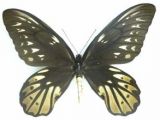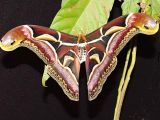It is impossible to be fooled when seeing these insects. Butterflies and moths make the Order Lepidoptera. These insects would fly around during the dinosaur era, 140 Ma ago. First were the moths, butterflies appearing much later. The oldest known butterfly fossil is 40 Ma old: Prodryas persephone, discovered at Lake Florissant, Colorado.
The name Lepidoptera means "scaled wing" in Old Greek. Not only the wings, but the body too is covered by scales, which confer the vivid colors and patterns. Lepidoptera are found everywhere, from the Poles to the Equator, and their variety in size, models, colors and patterns is amazing. The wings of some tropical butterflies are mounted in brooches and amulets.
Currently, the Lepidoptera Order is made up of 260,000 described species and their real number could be even higher. 20,000 species are counted as big butterflies. As in the case of many insects and warm-loving creatures, the highest variety is found in the tropics, where also the biggest species dwell.
The separation butterfly/moth is relative. Butterflies fly during the daylight, moths during the night; the first would have relatively brighter colors. When resting, butterflies keep their wings raised vertically, while the wings of the moth cover its abdomen.
The largest butterfly inhabits the rainforest of the eastern New Guinea: the Queen Alexandra butterfly (Ornithoptera alexandrae), with a wingspan of 28 cm (12 inch). This is more than the wingspan of many little birds. Their body length is 8 cm (3.2 inch) and it weighs 12 g. Queen Alexandra's Birdwing protects itself with a poison that comes from a pipevine plant the animal eats during the caterpillar phase, while the adult only sucks vegetable liquids and nectar.
In tropical America, the biggest species is a swallowtail butterfly, Papilio homerus (photo center), with a wingspan of 15 cm (6 inch). The biggest African butterfly is also a species of swallowtail, Papilio antimachus (photo below), whose wing opening reaches 23 cm (11.5 inch).
Amongst the largest moth species is Archaeoattacus edwardsi from India.
The blue dwarf butterfly, Brephidium exilis (from North America) is probably the smallest world's butterfly, with a wingspan of 1.5-1.9 cm (0.6-0.7inch)". In Europe, the smallest butterfly is the blue Cupido minimus, with a wingspan of 2.4 cm (1 inch).
Any butterfly has four developmental stages: egg, caterpillar (larva), nymph and imago (adult). The length of the cycle may vary from several weeks to several years.
Usually butterflies lay more than 1,000 eggs, but very few end the cycle. Usually, the female lays her eggs on leaves or plant stems, but some species inhabiting grasslands spread their eggs while in flight. The aim is the same always: the hatching caterpillar must be placed as close as possible to its host plant. From hatching to the maximum size, a caterpillar increases 4,000 times in size!
The butterfly Heliconius lays its eggs on the leaves of the passion flower (Passiflora). The hatching caterpillars consume plants' leaves. As a reaction, the plant turned some of its nectar glands in small yellow structures resembling the butterfly eggs. Flying butterfly females looking for a place to lay their eggs think the place has been occupied by another female and seek for other plant. On the leaf ribs, rigid hair formed, limiting the caterpillar's movements. Moreover, some nectar glands attract ants and wasps that attack the caterpillars.
Many caterpillars have the capacity to produce silk; special glands secret a liquid protein that hardens in contact with the air, forming a thread. Caterpillar form the base diet for many birds, mammals and insects, that's why they have developed many defense methods, from mimicry to the assimilation of toxic chemicals from the food, which keep the predators away. The poison can be transmitted to the adult phase, like in the case of the monarch butterfly of North America. The monarch butterfly of North America is also famous for its capacity to make 3,200 km (2,000 mi) long migrations, a total record in the insect world. The caterpillar of Cucullia artemisae mimics a withered flower so well that predator insects ignores it.
The mouth parts of the adult butterflies are transformed into winded tubes they can use just for sucking nectar and other liquids (like the juice of rotten fruits, tree sap, honey or even sweat or corpse secretions). Butterflies can extract salt and humidity from cattle's tears and dung. Some butterflies do not even feed when adults.
Butterfly males have an extremely well developed sense of smell. Their sophisticated feather-like antennae (where the smell sensors are placed) will pick up just one molecule of pheromone, tracking a female found 11 km (7 mi) away.
Unlike other insects, butterflies have an incorporated heating system: when requiring heat, they open their wings that act like solar panels and tilt them in the direction of the sun. The moth called Celerio euphorbiae can raise its body temperature by means of muscular contractions, to 30-40o C before taking off. This creature is also one of the rapidest flying insects. The emperor moth (Saturnia pavonia) raises its body temperature to 20o C before flying. The cabbage white butterfly (Pieris) has a wing rhythm of 5-10 beats per second.
Nowadays, butterfly farming is a commercial activity which is an ingenious, nice and ecological way of contributing to the preservation of many butterfly species.
During the '70s, an exhibition of living exemplars was held in Guernsey (off the English shore). The organizers wanted to recreate a tropical forest full of colorful butterflies.
But most tropical species have short life spans, just two-three weeks, and it was difficult to transport them securely and preserving them healthy for thousands of km. This way the idea of commercially breeding butterflies emerged.
The butterflies are grown in special greenhouses. They are totally closed, to avoid the predators from eating the eggs. In nature, the survival level of the eggs is 2 %, but in a butterfly farm it's about 90 %. Currently, butterfly farms are found in the US, El Salvador, Costa Rica, Philippines, Kenya, Madagascar, Malaysia, Taiwan and Thailand.

 14 DAY TRIAL //
14 DAY TRIAL // 

